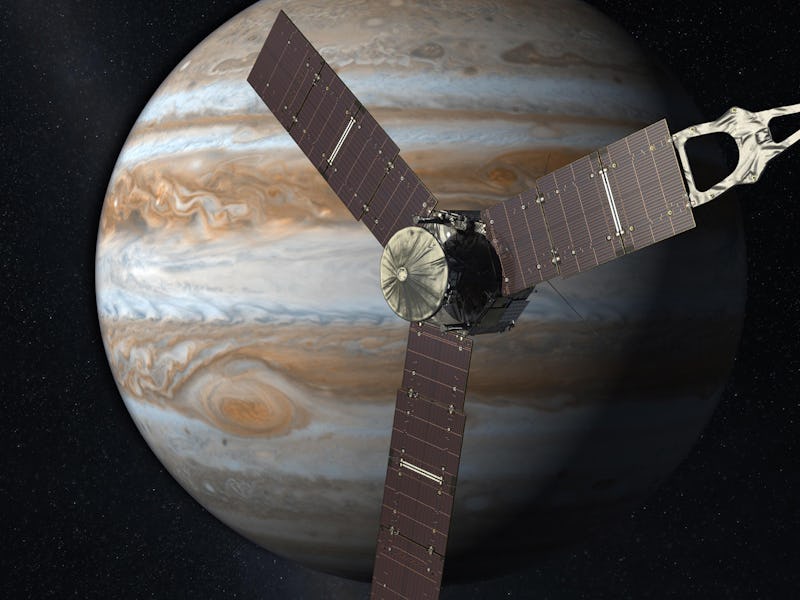'Juno' Has Reached Jupiter: Now the Fun Begins
"We just did the hardest thing NASA has ever done!"

The five-year, 1.75 billion-mile journey closes one chapter and opens a new one. NASA’s Juno spacecraft has finally made it to Jupiter and successfully inserted itself into the gas giants orbit, to begin a 20-month orbital study of the largest and most extreme planet of the solar system that will hopefully unlock mysteries of how planetary systems arise and how planets themselves are born.
“It’s almost like a dream coming true right here,” Scott Bolton, principal investigator for Juno, told reporters at a NASA news conference early Tuesday morning, hours after insertion maneuvers were initiated. “We’re there, we’re in orbit — to conquer Jupiter.”
At 11:18 p.m. Eastern, NASA started the 35-minute main engine burn for the spacecraft as it approached the planet from the north pole. Reaching a top speed of about 165,000 mph, Juno sped faster than any other human-made object has traveled, before the engine burn slowed the spacecraft down to about 1,212 miles per hour.
The spacecraft needed to start braking about 2,609 miles from the planet in order to get itself into the best position for its scientific work.
“The more you know about the mission, the more you know just how tricky this was,” said Diane Brown, director of the Resources Management Office at NASA HQ.
It takes 48 minutes for a signal from Juno to reach Earth. The spacecraft was fitted with its own automated system that would reinitiate the engine burn sequence without waiting for instructions from NASA. It’s nerve-wracking to think Juno may have needed to figure out the orbital insertion on its own, but thankfully everything seemed to work without a hitch. Juno managed to hit its burn targets within a second of previous predictions.
In addition, there were two big obstacles for NASA to contend with: the first was Jupiter’s extreme radiation belts, created by Jupiter’s intense magnetic fields that cause particles to move at the speed of light and essentially fry any naked electronics to shit. The background radiation Earth is exposed to is about one-third a rad. By comparison, Jupiter’s environment possesses a radiation environment that screeches up to about 20 million rad. Heidi Becker, Juno’s Radiation Monitoring Investigation lead, says Juno was basically being exposed to about a million dental x-rays.
The second obstacle that NASA hadn’t discussed very much before is the ring of debris that surrounds Jupiter — comprised of dust and meteorites. “Juno has to pass through these rings,” Bolton told reporters Monday afternoon. “We do not know how close to the planet they actually go.” A single big piece of dust or a meteorite could instantly destroy Juno.
“In short, the environment is the scariest part of the scariest place that we know about,” said Becker on Monday.
Luckily, NASA’s engineers have designed Juno to be something of an armored tank. The spacecraft’s instruments are encased in a “radiation vault that is basically a 500-pound, half-inch thick layer of titanium that will mitigate exposure to radiation. The spacecraft’s three solar arrays are 60 square meters in size, and able to turn the sunlight hitting Jupiter (about 1/25th the amount we get here on Earth), into 500 watts of power.”
Why go through all this trouble to study Jupiter? The planet holds secrets and information about the early history of the solar system, and how planets in the universe (especially gas giants) form and evolve. Juno will be studying the planet’s magnetosphere, atmosphere, geology, and gravitational fields. Among the big questions the spacecraft will try to answer is whether Jupiter has a rocky core or not and how much water is contained within the gas giant.
Juno’s scientific instruments were turned off five days ago in order to ensure the focus of the spacecraft was solely on a successful orbital insertion. With that taken care of, Rick Nybakken, Juno’s project manager, went ahead and tore up the contingency communications procedure he and his colleagues had drafted up in case of a failure. “We don’t need that anymore!” he exclaimed Tuesday morning. The team will soon fire up the instruments once again to begin collecting new data.
The spacecraft is currently in a 53-day orbit around Jupiter, which means August 27 will be the next time Juno gets to snap some sweet close-ups of the planet. Then, on October 19, the spacecraft will undergo another engine burn to swing into a 14-day orbit — and that’s where the science fun really begins.
It’s just the beginning.
Updates:
11:39 p.m. — Bolton confirms Juno is officially in Jupiter’s orbit. The team is still not sure if it’s in the orbit NASA is looking for, but Juno has technically made it.
11:54 p.m. — Burn is complete; Juno is in NASA’s target orbit around the planet! The burn was just one second off initial predictions.
Overheard at mission control:
- “You’re the best team ever!”
- “We just did the hardest thing NASA has ever done!” said Rick Nybakken, Juno’s project manager.